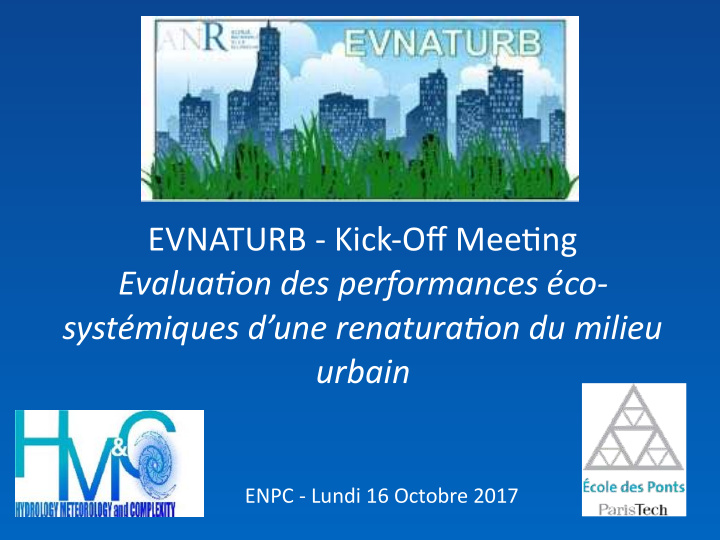



EVNATURB - Kick-Off Mee3ng Evalua&on des performances éco- systémiques d’une renatura&on du milieu urbain ENPC - Lundi 16 Octobre 2017
This afternoon • 15h15 - 15h30h: Arrival • 15h30h - 16h: Presentation of the project and its members • 16h - 16h30: Thematic presentation on evapotranspiration measurements • 16h30 - 17h: Thematic presentation on pilote sites • 17h - 17h30: Thematic presentation on modelling tools • 17h30-18h: Presentation of Marie-Claire Ten Veldhuis from TU Delft • From 18h: visit of the Green Wave pilot site
Multi-scale observation Multi-scale analysis Complex system approach for modeling Chair Hydrology for Resilient Cities
Vincent Callebaut ➡ Poor knowledge about the physical processes ➡ Lack of modeling thermo-hydric coupling tool ➡ Few works dedicated to urban biodiversity ➡ No link between eco-system services and operational constraint & objectives
Objectives Couple hydrology, thermic, Characterize the spatio-temporal urbanism & biodiversity viability through scales Consider local socio- Develop a scientific network environmental stakes and devoted to BGS monitoring constraints Development of the EVNATURB platform Assessment tool to quantify the multi eco-system services provided pb BGS at the urban project scale
Organization Work Package 2 Work Package 1 Thermo-hydric modelling Monitoring network & Characterization of the spatio-temporal variability • Develop thermo-hydric couplings • Parameter the biodiversity • Study thermo-hydro behaviour of BGS • Assess BGS thermo-hydric • Characterize the spatio-temporal performances at different scales variability of the involved processes • Follow performances over time • Create an ‘Observation’ database Work Package 4 Work Package 3 Development of the EVNATURB BGS implémentation platform • List social and environmental factors • Develop a user-friendly interface leading BGS implementation • Produce the input files required to • Associate plant species and substrates compute thermo-hydric impacts to their ecosystem functions • Demonstrate the EVNATURB platform on • Define quantitative indicators real case studies • Select real case studies
WP1: Monitoring network & characterization of the spatio-temporal variability • Measurement of evapotranspiration fluxes Odhiambo et Savage, 2009 Cerema Ile de France • Characterization of spatio-temporal variability • Creation of database devoted to BGS Cerema Ile de France
WP2: Thermo-hydric modelling • Improvement of evapotranspiration estimation in SOLENE-Microclimat • Parametrization and Validation Wide range of configuration • Development of a Multi-scale modeling s e l a c Multi-Hydro s h g u o r h T Coupling
WP3: BGS implementation • Review of local environmental constraints and objectives climatic geomorphologic regulatory • Classification of BGS ecosystem functions • Definition of case studies ???
WP4: Development of the EVNATURB platform • Design and development of the EVNATURB interface • Computation of environmental indicators • Demonstration of real cases Multi-HydrO Module de Module de précipitation ruissellement Module Module d'assainissement d'infjltration
WP4: Development of the EVNATURB platform Environmental constraints Layout of the urban and objectives project BGS proposal Selection of Thermo-hydric (scenarios) indicators simulation Assessment of the eco-system services
Interna'onal Scien'fic Board Consortium Dissemina(on Strategic & Scien,fic Steering Steering commi,ee Pierre-Antoine VERSINI Thema0c mee0ngs Communica0on strategy Final workshop Innova&on & Transfer Research & Development Stakeholders board Academic members
Planning ?
Impacts and benefices Teaching Communication Final workshop Industrial impacts
Multifunctional Multi-scale aspects Systemic Multiple approach interactions
Vincent Callebaut
Recommend
More recommend